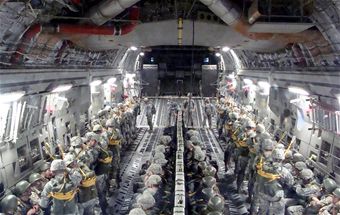 |
| |
| Photos | |
 |
Paratroopers from the U.S. Air Force, the U.S. Army and the Italian army prepare for a jump from a C-17 Globemaster III March 31, 2011, above Italy. (U.S. Air Force photo/1st Lt. Maria Amistoso)
|
Download HiRes
|
|
|
|
Airmen contribute to training, operational missions in Italy
Posted 4/4/2011
 Email story
Print story
Email story
Print story

by 1st Lt. Kathleen Polesnak
97th Air Mobility Wing Public Affairs
4/4/2011 - ALTUS AIR FORCE BASE, Okla. (AFNS) -- Eleven Airmen from here traveled to Italy aboard a C-17 Globemaster III recently to help three U.S. and Italian army and air force units fulfill airborne training.
During their week-long stint, they executed 1,480 paratrooper jumps.
"We do joint airborne air transportability training, a way for the Air Force and Army to train together in a situation that will be similar to what we do in a contingency operation," said Capt. Isaac Adams, the 58th Airlift Squadron tactics flight commander and the aircraft commander for the trip to Italy.
Both the U.S. and Italian units were grateful for the much-needed training.
"We could not have imagined in our wildest dreams how effective both the military and civilian Airmen would be at providing the sole support for over 1,400 joint and coalition paratroopers," said Lt. Col. Eric Chapital, the 8th Air Support Operations Squadron commander. "It was amazing to see them work. For four days, they provided lift after lift in support of hundreds of jumpers at a time. It is safe to say that the jump would not have happened without every member of the team."
The 11 Airmen from the 97th Air Mobility Wing consisted of several pilots, loadmasters and civilian maintainers, as well as two intelligence officers who were witnessing airdrop operations for the first time.
"It was my first time seeing an airdrop; I was nervous, imagining jumping out of a plane," said 1st Lt. Maria Amistoso, a 97th Operations Group intelligence officer. "Everyone was tense, actually. On the pilot side, the geography was a little tricky. There was a mountain in front of the drop zone. The Army airborne hadn't dropped out of a C-17 in five years, and (the intelligence officials) had never seen it before."
Amistoso and her counterpart, Capt. Theodore Randles, said they planned to tag along with the aircrew for multiple airdrops, but their plans quickly changed after they visited the 31st Operations Group intelligence cell at Aviano. The unit was swamped, undergoing 24/7 operations in order to support Operation Odyssey Dawn.
"We said 'we can help you' because they were so over-tasked," Amistoso said. "We wanted to alleviate some of the workload, and we ended up being key players for the few days that we were there."
The two officers assisted with mission report analysis and tracking missions occurring in real time. This was also the lieutenant's first operational exposure.
"It was really exciting to see that what you're doing is dynamically affecting a real-world situation and you rarely get that chance at Altus," she said. "Getting to work with not only intel, but also the Army airborne, the firsthand experience of seeing the cooperation between air power and ground power coming to work was awesome."
Amistoso wasn't the only one experiencing firsts on this trip. This was the first time Adams and his aircrew developed the entire mission and training plan for this kind of mission, from flight plans and diplomatic clearances, to working with the Army mobility liaison officer to set up airdrops.
"You really get into the nuts and bolts and do planning for stuff we don't normally do, (such as) how to get clearances, how to fly across the ocean, etc.," Adams said. "It is very rare for Altus to go and fly an (overseas) mission with foreign government jumpers. The planning involved and the training that we gained through working with several different agencies, especially the foreign ones, were invaluable and hopefully something we can do more of in the future."
As a trainer, Adams said he also appreciates the lessons learned during the trip that he can now share with his students.
"We were able to get three different units combat ready for any airborne operations that they have and we were able to take that knowledge from working with them and bring it back to the students," he said.
All totaled, there were 59 jumps for the U.S. Air Force, 39 for the Italian army and 1,382 for the U.S. Army, amounting to 1,554 people and 413,000 pounds of cargo transported. |
|
|



